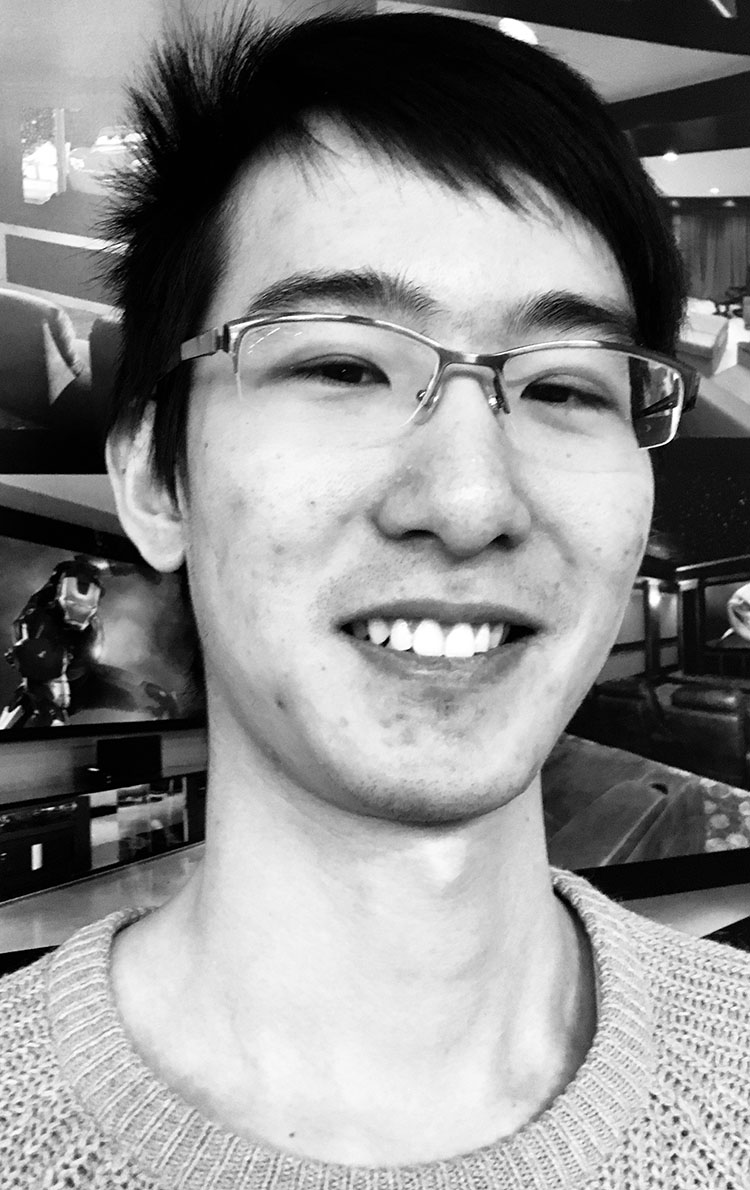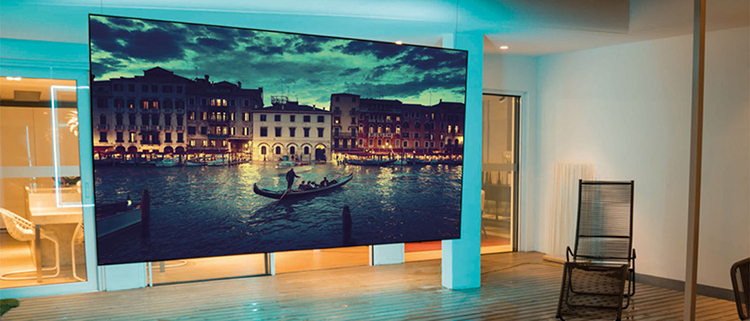
When designing a good home theater, there are many components that need to work favorably together to create synergy and audio-video bliss. You’ll need to do a little homework to decide if those components are the best choice when other factors such as the room are considered. The choice of projection screen is one such component. It’s always a pleasure to calibrate a client’s home theater when good advice resulted in a quality system with the right screen. Considerations such as ambient light, screen size and aspect ratio, choice of display, and projector mounting distance all need to be thought out carefully.
When considering a screen and projector purchase, you’ll want to make the right choices to turn your home theater dreams into reality. We at Secrets of Home Theater and High Fidelity would like to help you make the right choices. Today we’re highlighting the Canadian company EluneVision Screens in an interview with its product developer, Gary Sun. We appreciate him taking the time to meet with us so our readership can learn what they have to offer for your dream theater.
Secrets Michael Osadciw: I’m here with Gary Sun, product developer of the EluneVision. Thanks for being with us today. When I walked into your facility, there are many rooms here that highlight EluneVision screens and samples. Has film been a long-time passion of yours over the years?
EluneVision Gary Sun: Yes absolutely, I’ve always loved movies and I try to go every other week. I love the image as well, because image is very important.
Secrets Osadciw: There’s nothing like watching movies on a big screen at home.
Sun: Absolutely!
Secrets Osadciw: It sounds like you’re in the right field (laughs). So, tell us about how your education landed you working for EluneVision Screens.
Sun: Yes absolutely. In order for us to develop the material for the screens, we have to research and develop those technologies ourselves. It involves a lot of testing and a lot of work with our strategic partner to make those material changes happen. I’m very happy to have come from a physics background and use my knowledge to efficiently work with these products and these projects.
Secrets Osadciw: When you speak about changes, do you make changes because you’re looking at the product and are not satisfied with it during development? Or do you make those changes after development by listening to feedback from your clientele? How do you determine which changes to make?
Sun: Both. Mostly it’s because we do service and statistics with our clients and so we gather information, for example, like what our dealers would like to see in our screens, in our motorized screens, and then we look at the information and add features like a 12-volt trigger, a 12-volt wireless trigger, and we put those features in to make it easier for people.
Secrets Osadciw: Tell us about EluneVision screens. Tell us what the company sets out to do for the home theater market and the gaming market.
Sun: EluneVision’s slogan is “Watch the Future”. We focus on performance, support, reliability, and affordability. EluneVision has always been a brand that offers great products at affordable prices for everybody.
Secrets Osadciw: I’ve heard of the company for many years even though the brand is relatively new to the screen market. Do you feel that the company, based on these principles, have caught on in the consumer market?
Sun: Yes, absolutely. We have pushed out seven new products in the past two years, seven new product lines, not just new products.
Secrets Osadciw: Before you explain some of those, just how long has EluneVision been on the market for our readers who are not familiar with the product?
Sun: EluneVision was founded in 2007. I’m happy to have gotten on board in the past few years.
Secrets Osadciw: How did you become acquainted with Dave Hao? (The owner) How did the two of you meet?
Sun: Well, I’m just some guy who he picked up off the street! (laughs)
Secrets Osadciw: So, he found you on the corner of Barton Street in Stoney Creek (laughs), so I’m assuming you did work at the Stoney Creek location?
Sun: Yes, I worked in Stoney Creek before the facility moved to Oakville, Ontario. So, when the company moved, I got moved as well. More seriously though, Dave has always been trying to grow the company extensively, and in order to do that, he’s always been very, to use the word – picky, when choosing his staff. So I was luckily one of the persons chosen. So for all of the staff you see here, we’ve got a very dedicated procedure for that. We try to motivate great employees with great service.
Secrets Osadciw: And where did you graduate?
Sun: I graduated from McMaster University in Hamilton, Ontario in Physics.
Secrets Osadciw: And why the move from Stoney Creek to Oakville?
Sun: The motivation was the growth – we’re a growing company and we needed a much bigger place for more staff, more stock, and most importantly moving closer to the GTA (Greater Toronto Area), gave us more opportunity and made sense logistically.
Secrets Osadciw: Stoney Creek is a great family town so I understand the move. Sitting in this Oakville location with you shows how much larger the company has grown compared to the Stoney Creek office. We’re sitting in the warehouse here surrounded by your screens. There are so many boxes in here, so tell us about your manufacturing process and stocking details.
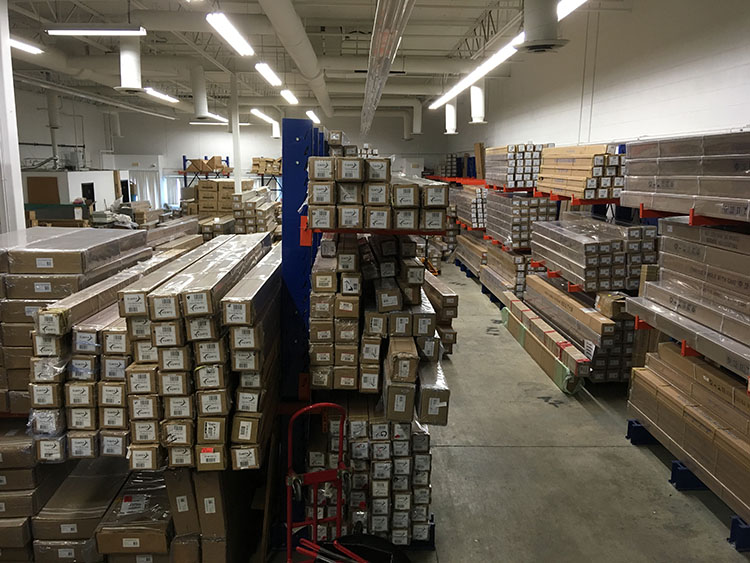
Sun: We consistently keep between 3000 and 4000 screens in stock and at peak time typically 6000. Those big cartons there are motorized screens, we’ve got fixed screens here, and manual pull-down screens as well. We also have fast-fold portable screens on the other side. This, what you see here, is just the tip of the iceberg. We’ve got another warehouse not far from here in Mississauga that distributes our product for us to our distributors at Best Buy, Staples, and Ingram.
Secrets Sponsor
Secrets Osadciw: With those screens you mentioned, other than the home theater market, what other markets does EluneVision support?
Sun: Commercial. Other than home theater, we tend to provide for rentals with fast-fold screens, assembled screens for outdoor use, and for concerts, churches, and business applications. We also offer in-ceiling screens, those recessed series screens not just for home theater but for commercial in offices and presentation rooms.
Secrets Osadciw: Because the readership of Secrets of Home Theater and High Fidelity are mainly looking for video projection screens for home theater, can you tell us more about the materials that you’ve provided as samples here. Can you tell us what each of these are and how they will work in different applications in a home theater system?
Sun: So those materials are specifically engineered for a home theater environment.
Secrets Osadciw: The first one here looks like a white screen without a reflective layer on it.
Sun: That’s the Reference White 1.0. It comes with a black backing for home theater, since a black backing is very important, so the light is being reflected and absorbed so it’s not going through to the wall.
Secrets Osadciw: So, are you saying that if the screen has a black backing, there are improvements in reflected light to the front of the screen?
Sun: That is correct. In contrast to what we were doing before where we were using a semi-translucent material and adding a black backing at the end of the install. We’ve made an improvement and made it one piece now. In the end it’s easier to install and it looks great. There’s better image quality because in terms of physics, there’s less image going through the material and more light being absorbed and more light being reflected.
Secrets Osadciw: And is that part of the reason why you consider this material to be the “Reference 4K” product?
Sun: No, the real reason is because the Reference 4K has very nice uniformity. It’s a very uniform product of gain and diffusion, and my means of that the viewing angles are very good. There’s also no hot-spotting as well. The screen has very minimal texture that you’ll probably never see at regular viewing. There’s no graininess, and no sparkling.
Secrets Osadciw: Especially while in the era of 4K when pixels are getting smaller, we’ll want to see those finer details without the screen imposing any artifact as well.
Sun: That’s correct.
Secrets Osadciw: Are there any other advantages to the Reference 4K material?
Sun: Absolutely. Other advantages include, like you said before, the better image by seeing the smaller pixels clearly, and the material is designed to be more elastic, and designed to have very good tensioning systems that will give the user a flat screen over the years, over the long run.
Secrets Osadciw: Then what our readers should understand is that if they want to see the image exactly as projected, without any change, the Reference 4K would be the best screen choice?
Sun: That is correct. Reference 4K 1.0 gives the most accurate image reproduction.
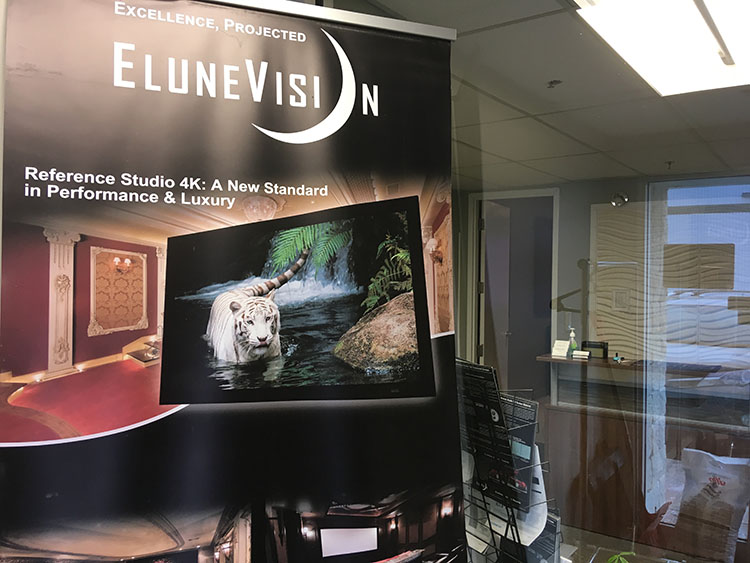
Secrets Osadciw: Would there be any application where the Reference 4K screen is not the best choice?
Sun: It depends on what the system is focused on. For example, the Reference 4K does not resist ambient light very well compared to ambient light-rejecting material like the one I have here – the Aurora screen material – and it’s not an acoustically-transparent screen so it cannot be used with the speakers behind. It is also not a short-throw screen material, and we can brush up on that a little later.
Secrets Osadciw: Short-throw material?
Sun: Yes, it can be used with short throw but the ambient light rejecting properties are not that great.
Secrets Osadciw: What other screens does EluneVision have that can be used in those applications?
Sun: This material that I have here is the AudioWeave MKII. This is the newest generation of acoustically-transparent screen. It’s made with a very dense weave.
Secrets Osadciw: Oh yes, I can see that it’s very tight.
Sun: It’s incredibly dense but however it remains the same perforation area as an acoustically-transparent would and will give you great image and very, very good sound.
Secrets Osadciw: Is this also considered to be a 1.0 screen?
Sun: It’s actually a 1.15 to counter the fact that we actually have to have some perforation area.
Secrets Osadciw: There’s a loss of light due to perforation, so you are making it up with the gain.
Sun: That’s correct.
Secrets Sponsor
Secrets Osadciw: And what material is it made from?
Sun: This is made from a very dense weave so it’s a PET-based material.
Secrets Osadciw: I feel the texture is quite different.
Sun: It is so dense that from a few feet away it’ll be unnoticeable.
Secrets Osadciw: I love the idea of placing speakers behind the screen if it can be done. When hearing the dialog coming from the middle of the screen rather than below or above in the home environment, the suspension of disbelief is greatly enhanced. Some audiophiles may be wondering what the potential losses are of putting the speakers, or just a center speaker, behind the screen. Is there a measurement of the loss in decibels you can provide us?
Sun: Yes, you get approximately 0.2-0.5dB loss, depends on your speaker placement and the material, but for this material the average is about 0.3dB.
Secrets Osadciw: And its good for our readers to know that there is no material that is 100% acoustically-transparent. How does your weave material interact with pixels and overcome the challenges often associated with good image quality? Is there moiré?
Sun: The weave is moiré-free. Compared to the MKI, we had to do some engineering and testing to make a completely different weave in the MKII. We got rid of the grid-like weave patterns and made them more like the scaffolding lines like you see here. (refers to sample) This new pattern will greatly reduce the probability of moiré compared to the previous generation. There’s also a certain orientation of this screen material when assembled to the frame and when that’s been executed properly, you will never encounter moiré.
Secrets Osadciw: When was the MKII developed?
Sun: The MKII was developed approximately three years ago.
Secrets Osadciw: How is it that you go about changing the properties of your screen material? Is it because you’re taking extra care about the way it looks to get it perfect or getting feedback from your clients? How do you go about making changes and deciding when that happens?
Sun: MKI was a great product. Although some of our customers felt like the screen compromised a bit too much on the video image. The sound was great. But we decided to take it a step further to give it a better image while having 0.2-0.3dB attenuation of the sound. But that’s the trade-off of the material characteristic, this dense weave, to get the better picture compared to the previous version.
Secrets Osadciw: Tell me more about the materials you have here. There’s a gray screen.
Sun: This gray screen is called the Reference 4K Aurora. We’ve been developing this product for two years and were finally able to launch it as of last summer. It’s our first-generation ambient light rejecting screen. As you can see it’s a gray screen material with a sheen.
Secrets Osadciw: I can see how it’s lighter or darker depending on how the light is hitting it.
Sun: This screen is the idea of an ambient light rejecting material giving you a good amount of ambient light resisting properties. You can have this material in a living room and not close your window blinds during the daylight and still watch the projection screen. The sheen has ambient light reflecting properties and eliminates the noise from the ambient light going to your eye. The light that you will see is just the projector’s image reproduced on this screen. This screen material is also very great in dark and studio environments as well. That’s why it’s gray based to give more contrast. The material is 1.3 gain, it’s a little higher gain then the reference material, and gives a little more pop with accurate colors.
Secrets Osadciw: We’ve discussed three materials here. Are all three materials available on most of your product? Let’s use that to talk about the frame system that EluneVision uses. I’ve become familiar with the newest one which uses the NanoEdge. Tell us how you come up with what frames to use and how our readers can use them in certain applications with the material.
Sun: We have been improving our frame and tensioning system for years. The thin bezel frame is the trend and we launched that two years ago. We’ve been trying to go thinner and thinner since then to give it a more sleek and modern feel —
Secrets Osadciw: –and something needs to be said to have a bit of black border to give the image the contrast it needs from the wall rather than going directly to the edge as I’ve seen elsewhere.
Sun: Correct. We tend to stay away from the borderless because people do tend to have overscan as well. It serves for functionality with contrast and overscan. In terms of the tensioning system, it’s actually a little bit difficult to have a thin border like that. Some people look at the screen and see that thin border and say “Is it stable? Is it sturdy?” But that’s where the beauty comes in. A thin frame screen is much more complex than a traditional frame because it consists of a much larger inner frame system so a lot of the frame is on the inside. It’s recessed and hidden by the material. Only a portion of it that you see is the velvet, the thin frame, so the screen itself it very sturdy, very durable, more so than traditional frames. We had to re-engineer the tensioning system because the screen structure is different now.
Secrets Osadciw: How does the tensioning system work on your fixed screens?
Sun: Right now, it’s a two-stage tensioning system. You have to use an equalization rod and a series of tensioners by springs. The springs will evenly distribute the force onto the equalization rod, and the rod will pull along the screen material without giving too much force along a single spot. It will be even in all four directions across the frame.
Secrets Osadciw: What is the recommended installation procedure for something like that?
Sun: The recommended procedure is fairly simple. It’ll probably take about an hour to two. With the installation procedure, you’ll need to have a clear area approximately a foot or two larger than the size of the screen for you to assemble it. The box itself is fairly small so all you need to do is bring it into your house and into the theater room.
Secrets Osadciw: Move the furniture out of the way and put it together.
Sun: It’s very simple, not hard at all.
Secrets Osadciw: Lay it down on the floor with it protected.
Sun: There will be tools provided, for example there will be floor mats for the floor for a cleaner installation, and gloves and tools for a safe installation. We’ve also had to improve the instruction manual to make it clear to everybody what to do and what to avoid.
Secrets Osadciw: You must make sure that the parts in the box are the same as what’s in the manual! (laughs) Moving on, are some of your screen materials only available with certain screen types, for example fixed frames get some materials that are different than manual pull-downs screens?
Sun: That’s correct. Actually, just a month ago we just launched the ambient light rejection screen in the motorized screen format. The other two materials, the Reference 4K and the Reference 4K AudioWeave have always been available in a motorized tab tension screen for 4K. They are available in fixed frames in quite big sizes.
Secrets Osadciw: Let’s talk about EluneVision and the ability to customize sizes. The typical aspect ratio for home theater is 1.78:1. You provide those as well as the 2.35:1 aspect ratio. What is the readily available sizes from smallest to largest? How easily are you able to make custom screen sizes as large as the consumer wants?
Sun: The smallest screen sizes in stock are 84” and 92” and then largest up to 150”, both 16:9, and then in 2.35:1 from 92” to 150”. We also offer custom sizes; they can be small or big. The biggest size that we’ve done was a 360” motorized screen that was absolutely huge – bigger than those 53’ trucks that you see. We also carry large sizes for commercial uses. For example, we have a product line called the Professional Large Motorized that can go up to 300” and usually stock large sizes like 220” or 240” in 16:9.
Secrets Osadciw: I’ve been involved in the home theater market for over 20 years and I remember the days when a big screen and projector would be in the size of 77” or 82”. Flat panels are slowing taking over those sizes and with better projectors available, projection screens are now on average bigger in homes. What have you found is the average diagonal screen size most popular with your brand in both 1.78:1 and 2.35:1?
Sun: In 16:9, it’s from 106” to 120”. For 2.35:1 dedicated home theater, it’s 120”-130”.
Secrets Osadciw: And within that 130” 2.35:1 screen, there’s about a 110” diagonal 16:9 image within that screen which is very satisfying for many viewers.
Sun: Exactly.
Secrets Osadciw: Do you feel that as Blu-ray and UHD Blu-ray continues to get better, more people are making the shift to 2.35:1 screens, demanding a wider experience? In movie theaters, gone are the times when the curtains opened up wider for scope films. With digital projectors and big theaters, it now seems width remains the same and there is curtain masking on the top and bottom to create the illusion of width, but the reality it’s just added height for 1.89:1. This seems to defeat the purpose of why movies are framed wider. In the home we can make it work, we can preserve that width because we’re in control of our rooms. Do you feel there is a consumer shift towards constant image height (CIH) screens to experience that width over traditional programming?
Sun: Yes. About three to four years ago, of all the screens we sold, about 10-20% of them were a 2.35:1 ratio. But as 3D and UHD has taken off as it did, for every ten screens sold, about four are now 2.35:1. So a lot of people are dedicating their theaters to 2.35:1 cinemascope screens over 16:9. The reason why people still purchase 16:9 screens is because people still want to watch TV and do gaming, because it’s a multi-purpose viewing screen. It’s still our main product.
Secrets Osadciw: I’m not into gaming, but I know you’re an avid gamer so do you find that you get many people into gaming reaching out to you for your screen?
Sun: Yes, its been steadily growing since a year ago when the major projectors began to offer a low-lag gaming mode. The gaming inquiries have been growing ever since. More and more people have asked how they can choose a projection screen for their gaming/theater room.
Secrets Osadciw: How is it that you choose the specifications for your screen material? Going back to an earlier conversation we had, you design the product here and co-produce it with your partners in China. How do you determine what sort of material you want to create? How do you know what the needs of the consumer are and say, “Hey, I want to fulfill this need” and say, “Let’s get to work and design a screen based on this need” and start creating specification for it? Can you tell us about that process?
Sun: Yes. First of all, we have to understand the market, what the customer needs. For example, an ambient light rejection screen with a slim bezel design. People will tend more towards a more modern, more trending design, and that’s where we step in and innovate new products for consumers. To do that, we have to pretty much start from scratch and toss out our previous designs and methods for tensioning that we use for fixed frame, and then we have to come up with, using our team here, we have to come up with a design. We take that design to our strategic partners and see if this is doable and realistic. Then we go back and forth, back and forth, developing and negotiating, and then in the end we’re able to provide a product that’s not ludicrous, and be affordable and first and foremost very good performance. The price point is always something that we try to make everyone be able to afford it.
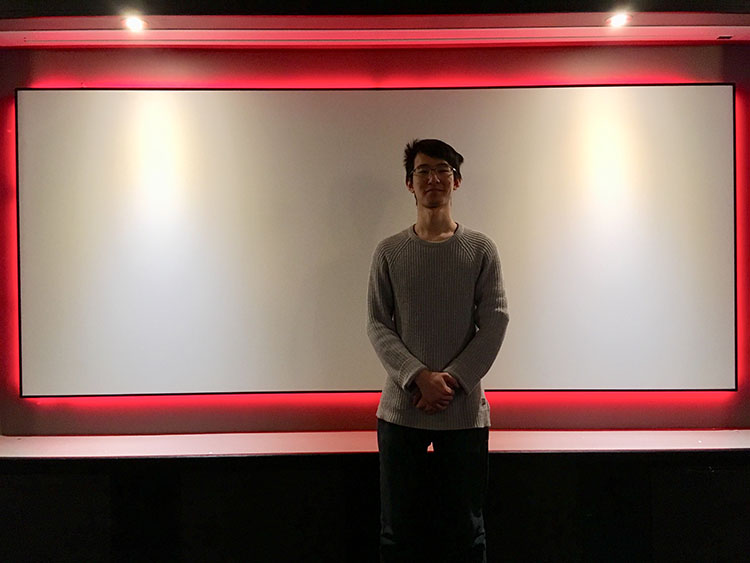
Secrets Osadciw: At this point it appears you have a good solid base of clients and dealers, a good solid lineup of screens, including that sleek and modern one with multicolored LED strip lighting around it adding a bit of fun to the room. So where do you see EluneVision moving forward with future developments? Can you give us a hint as to what else the company is planning?
Sun: I’m not sure if you’ve been noticing, but as of last year we’ve been exhibiting at CEDIA. We tend to give our customers a little sneak peak of what we’re gonna do. What we’re developing now will be soon finished in the next few years. They are short throw screens. Short throw fixed screens and short throw motorized screens. Today, the short-throw 4K projectors, the price is very high.
Secrets Osadciw: Yes, I’ve calibrated a few of the Sony short-throw 4K projectors for post-production companies. How would a short-throw screen assist in a short-throw application?
Sun: Short throw compared to long throw is a completely different concept. The projection angle is completely different, and by having a different angle, that means the viewer is sitting further way back while the projector is close to the screen. In that setup, it will require the screen to have a very specific reflecting angle for that light produced by the projector to be reflected to the viewer. In order to do that, it can only be achieved with a good amount of very uniform diffusion and also with ambient light rejecting ability that will also require the material to have a specific texture. For the screen material, being able to resist ambient light, while at the same time reflecting the image back at you at a non-reflective angle. That’s the technical term, but the reality is that short throw screen material will be completely different than the one’s we’ve seen on the market right now. It will be a different texture, because simply put, it’s different physics behind the short throw screens. And that’s why we’ve had to put our effort in to make sure our customers get the good product and be able to launch motorized screens and fixed-frame screens as well.
Secrets Osadciw: There are many certifications in the market such as ISF and THX, I calibrate video systems under these umbrellas as well as assisting in instructing new calibrators. Some of our home theater enthusiasts are aware of those product certifications. A few years ago, when I met you, I was teaching ISF in Toronto with Joel Silver and you came by with some screen samples that we began measuring with my Konica-Minolta CS-1000A. Is seeking a certification such as ISF or THX something that the company is planning on doing?
Sun: Yeah, absolutely. We have been planning on getting ISF certification for the Aurora screen material, however we’ll need to make some changes later on. We’re in the process of getting ISF certification for Reference 4K screen materials.
Secrets Osadciw: It sounds like some exciting times ahead for EluneVision! What words would you like to conclude this interview with?
Sun: With our slogan, “Watch the Future”. EluneVision has been a growing company, extending our product lines very broadly. We’d like to thank our customers and our loyal clients and we’d like to support new clients as we have for the last 10 years. We appreciate the support from Canadians since we’re a Canadian company.
Secrets Osadciw: We look forward to reviewing your screens in the future on the pages of Secrets of Home Theater and High Fidelity. Gary, thank you very much for meeting with us today and all the best for you and the company as you continue to deliver your performance products.
Sun: Thank you.



